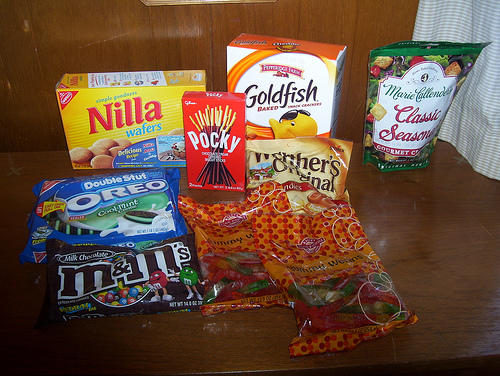
Death by M&M: The Problem with Food Dyes
by Sarah Parsons June 30, 2010
Photo Credit: Elyse Dewey via flickr
Step away from the M&Ms. And the Froot Loops, Kraft salad dressings, and Manischewitz Matzo Balls. And, well, basically every other processed product containing artificial food dyes, too. A new report from the Center for Science in the Public Interest (CSPI) highlights how synthetic food dyes contribute to medical conditions like cancers, allergic reactions, and hyperactivity. Bet those Fruit Roll-Ups don't seem so appetizing now, eh?
Every year, food manufacturers pump about 15 million pounds of synthetic food dyes into processed foods and beverages. CSPI's report, "Food Dyes: A Rainbow of Risks" (pdf), examined the potential health effects from consuming these artificial colors. Results of the study were truly frightening. Researchers found that the three most heavily used artificial food dyes — Red 40, Yellow 5, and Yellow 6 — contain cancer-causing compounds. Dyes like Blue 1, Red 40, Yellow 5, and Yellow 6 can cause serious allergic reactions in people, while other synthetic dyes are linked to hyperactivity in children.
What's worse is that use of synthetic food dyes is hardly on the decline. According to the CSPI report, since 1955, the country's seen a five-fold increase in the per capita consumption of food dyes. Which I guess makes sense, considering the bevvy of brightly colored sugary drinks, snacks, and processed foods that crop up on grocery store shelves every week. Take Action: http://food.change.org/blog/view/death_by_mm_the_problem_with_food_dyes#
Perhaps the most concerning portion of the report involves the food industry's use of the dye Red 3. In 1985, the FDA's acting commissioner said that Red 3 can induce cancer. And despite the fact that the FDA knew about this risk for, um, a quarter of a century, it's still perfectly legal for food manufacturers to use this dye in products. Every year, manufacturers put 200,000 pounds of the dye in treats like Betty Crocker's Fruit Roll-Ups and ConAgra's Kid Cuisine meals. Companies knowingly spend their marketing dollars hawking cancer-causing junk food to kids while the FDA stays mum. So much for living up to the agency's mission of watching out for consumer's safety.
Dyes aren't a vital ingredient in food products, either. They simply make goods more colorful. Skittles would still taste the same without their dyes, but then how could Mars, Inc. tempt consumers to "taste the rainbow"?
But even considering Americans' preoccupation with food's appearance, there still isn't a need to rely on artificial dyes. Manufacturers can easily use healthy, all-natural ingredients like pumpkin and carrot extract, strawberries, beet juice, paprika, red cabbage, and a grocery list of other items to color foods.
It's time that the FDA take consumers' health seriously and start regulating these harmful petrochemicals. Sign Change.org's petition that the FDA ban the use of Blue 1, Blue 2, Citrus Red 2, Green 3, Orange B, Red 3, Red 40, Yellow 5, and Yellow 6.
TAKE ACTION: http://food.change.org/blog/view/death_by_mm_the_problem_with_food_dyes#
Exactly! We at babyminding.com agree with you. Please take a look at our article on the same issue...
ReplyDeletehttp://babyminding.com/2010/07/06/goodbye-artificial-food-dyes-take-2/